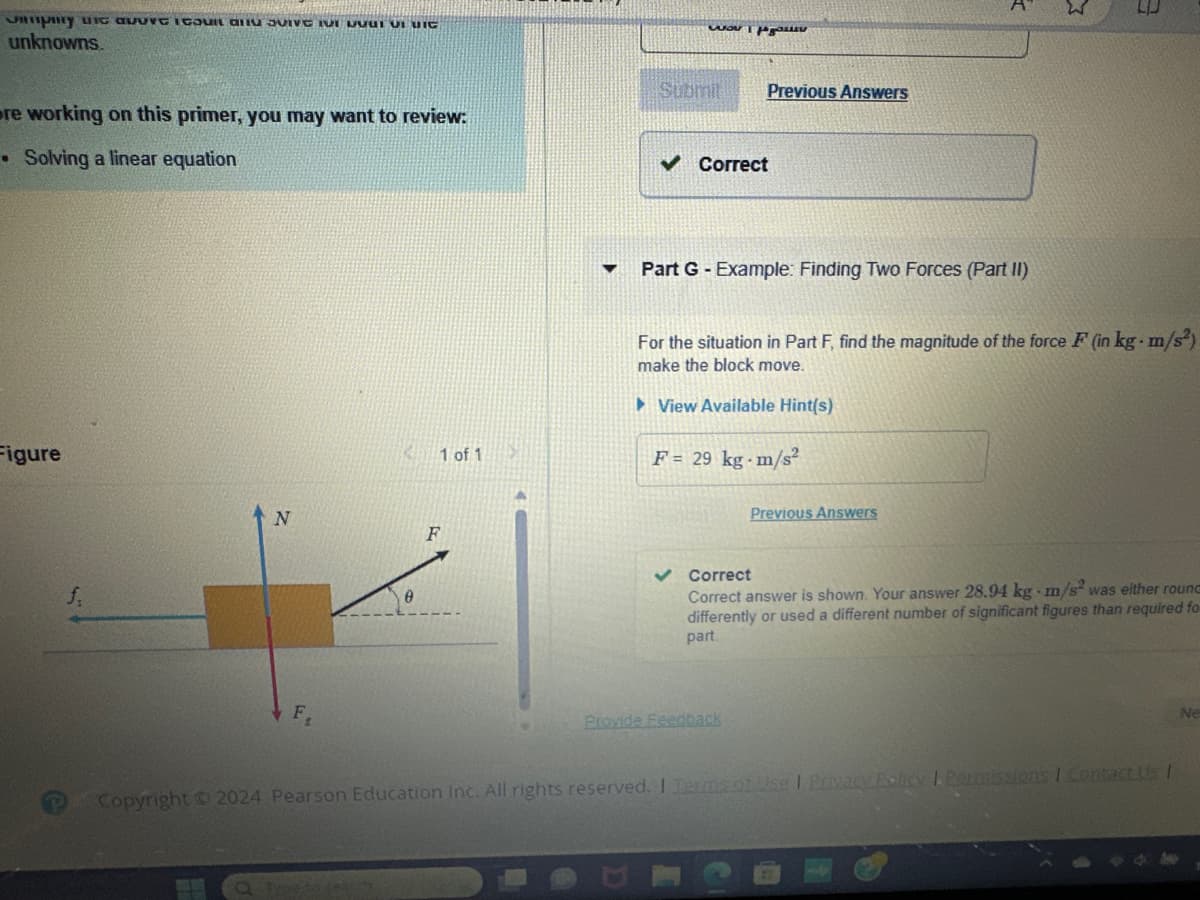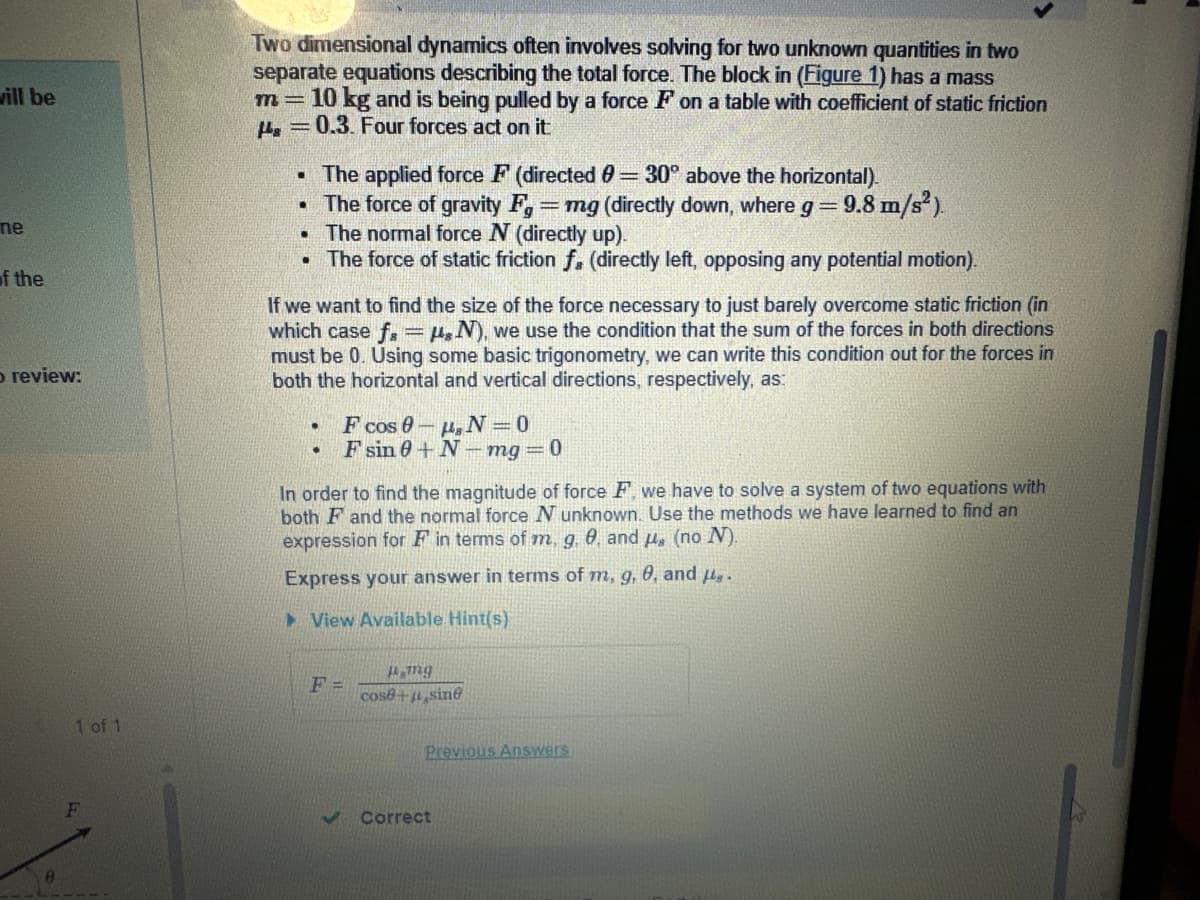Two dimensional dynamics often involves solving for two unknown quantities in two separate equations describing the total force. The block in (Figure 1) has a mass m= 10 kg and is being pulled by a force F on a table with coefficient of static friction He=0.3. Four forces act on it . The applied force F (directed 0 = 30° above the horizontal). - • The force of gravity F, = mg (directly down, where g = 9.8 m/s²). - . The normal force N (directly up). . The force of static friction f. (directly left, opposing any potential motion). If we want to find the size of the force necessary to just barely overcome static friction (in which case f= N), we use the condition that the sum of the forces in both directions must be 0. Using some basic trigonometry, we can write this condition out for the forces in both the horizontal and vertical directions, respectively, as: . . F cos 0-u, N=0 Fsin 0+N-mg = 0 In order to find the magnitude of force F, we have to solve a system of two equations with both F and the normal force N unknown. Use the methods we have learned to find an expression for F in terms of m, g. 9, and μ, (no N). Express your answer in terms of m, g, 0, and μg.
Two dimensional dynamics often involves solving for two unknown quantities in two separate equations describing the total force. The block in (Figure 1) has a mass m= 10 kg and is being pulled by a force F on a table with coefficient of static friction He=0.3. Four forces act on it . The applied force F (directed 0 = 30° above the horizontal). - • The force of gravity F, = mg (directly down, where g = 9.8 m/s²). - . The normal force N (directly up). . The force of static friction f. (directly left, opposing any potential motion). If we want to find the size of the force necessary to just barely overcome static friction (in which case f= N), we use the condition that the sum of the forces in both directions must be 0. Using some basic trigonometry, we can write this condition out for the forces in both the horizontal and vertical directions, respectively, as: . . F cos 0-u, N=0 Fsin 0+N-mg = 0 In order to find the magnitude of force F, we have to solve a system of two equations with both F and the normal force N unknown. Use the methods we have learned to find an expression for F in terms of m, g. 9, and μ, (no N). Express your answer in terms of m, g, 0, and μg.
University Physics Volume 1
18th Edition
ISBN:9781938168277
Author:William Moebs, Samuel J. Ling, Jeff Sanny
Publisher:William Moebs, Samuel J. Ling, Jeff Sanny
Chapter5: Newton's Law Of Motion
Section: Chapter Questions
Problem 105CP: Hanging from the ceiling over a baby bed, well out of baby’s reach, is a string with plastic shapes,...
Related questions
Question
How is it 29 kg.m/s ?

Transcribed Image Text:Sophy unt autour a ve v Dar vi DIC
unknowns.
re working on this primer, you may want to review:
• Solving a linear equation
Figure
f₁
N
F.
1 of 1
Q Type to search
F
wo
Submit
Previous Answers
Correct
Part G-Example: Finding Two Forces (Part II)
For the situation in Part F, find the magnitude of the force F (in kg- m/s²)
make the block move.
View Available Hint(s)
F = 29 kg-m/s²
Provide Feedback
3
Previous Answers
✓ Correct
Correct answer is shown. Your answer 28.94 kg m/s2 was either round
differently or used a different number of significant figures than required fo
part.
Copyright © 2024 Pearson Education Inc. All rights reserved. I Terms of Use | Privacy Policy | Permissions Contact Us I
Ne

Transcribed Image Text:vill be
ne
of the
o review:
1 of 1
Two dimensional dynamics often involves solving for two unknown quantities in two
separate equations describing the total force. The block in (Figure 1) has a mass
m= 10 kg and is being pulled by a force F on a table with coefficient of static friction
0.3. Four forces act on it:
•
The applied force F (directed 0 = 30° above the horizontal).
• The force of gravity F,= mg (directly down, where g = = 9.8 m/s²).
.
The normal force N (directly up).
.
The force of static friction f. (directly left, opposing any potential motion).
If we want to find the size of the force necessary to just barely overcome static friction (in
which case f= N), we use the condition that the sum of the forces in both directions
must be 0. Using some basic trigonometry, we can write this condition out for the forces in
both the horizontal and vertical directions, respectively, as:
•
.
F cos 0-, N=0
Fsin 0+N-mg = 0
In order to find the magnitude of force F, we have to solve a system of two equations with
both F and the normal force N unknown. Use the methods we have learned to find an
expression for F in terms of m, g. 9. and μ, (no N).
Express your answer in terms of m, g, 0, and H.
View Available Hint(s)
F=
mg
cose + sine
Previous Answers
Correct
Expert Solution
This question has been solved!
Explore an expertly crafted, step-by-step solution for a thorough understanding of key concepts.
This is a popular solution!
Trending now
This is a popular solution!
Step by step
Solved in 5 steps with 24 images

Knowledge Booster
Learn more about
Need a deep-dive on the concept behind this application? Look no further. Learn more about this topic, physics and related others by exploring similar questions and additional content below.Recommended textbooks for you

University Physics Volume 1
Physics
ISBN:
9781938168277
Author:
William Moebs, Samuel J. Ling, Jeff Sanny
Publisher:
OpenStax - Rice University

College Physics
Physics
ISBN:
9781938168000
Author:
Paul Peter Urone, Roger Hinrichs
Publisher:
OpenStax College

Glencoe Physics: Principles and Problems, Student…
Physics
ISBN:
9780078807213
Author:
Paul W. Zitzewitz
Publisher:
Glencoe/McGraw-Hill

University Physics Volume 1
Physics
ISBN:
9781938168277
Author:
William Moebs, Samuel J. Ling, Jeff Sanny
Publisher:
OpenStax - Rice University

College Physics
Physics
ISBN:
9781938168000
Author:
Paul Peter Urone, Roger Hinrichs
Publisher:
OpenStax College

Glencoe Physics: Principles and Problems, Student…
Physics
ISBN:
9780078807213
Author:
Paul W. Zitzewitz
Publisher:
Glencoe/McGraw-Hill